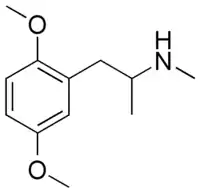Methyl-DMA
Methyl-DMA (2,5-dimethoxy-N-methylamphetamine) is a lesser-known psychedelic drug and substituted methamphetamine. It was first synthesized by Alexander Shulgin. In his book PiHKAL, the minimum dosage is listed as 250 mg, and the duration unknown.[1] Methyl-DMA produces slight paresthesia. Very little data exists about the pharmacological properties, metabolism, and toxicity of Methyl-DMA.
 | |
| Names | |
|---|---|
| IUPAC name
1-(2,5-Dimethoxyphenyl)-N-methylpropan-2-amine | |
| Identifiers | |
3D model (JSmol) |
|
| ChemSpider | |
PubChem CID |
|
CompTox Dashboard (EPA) |
|
| |
| |
| Properties | |
| C12H19NO2 | |
| Molar mass | 209.289 g·mol−1 |
Except where otherwise noted, data are given for materials in their standard state (at 25 °C [77 °F], 100 kPa). | |
| Infobox references | |
This article is issued from Wikipedia. The text is licensed under Creative Commons - Attribution - Sharealike. Additional terms may apply for the media files.